Climate Change Escapism
The Guardian recently introduced us to a series of images, produced by artists Pedro Armestre and Mario Gómez, for a new project by Greenpeace.
The images show us what Spain will look like in the future, in a world transformed by climate change.
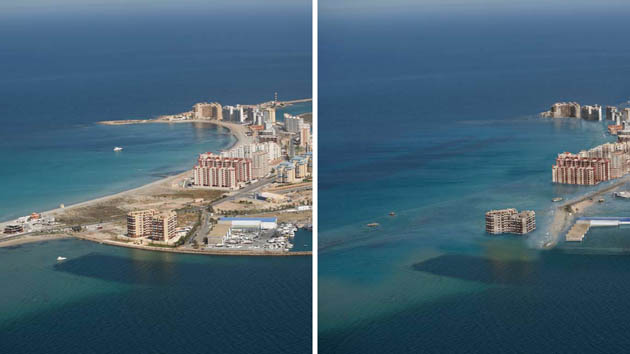 [Image: By Pedro Armestre and Mario Gómez].
[Image: By Pedro Armestre and Mario Gómez].
The basic idea here is that these visions of flooded resort hotels, parched farmlands, and abandoned villages, half-buried in sand, will inspire us to take action against climate change. Seeing these pictures, such logic goes, will traumatize people into changing how they live, vote, consume, and think. You can visually shock them into action, in other words: one or two glimpses of pictures like these and you'll never think the same way about climate change again.
But I'm not at all convinced that that's what these images really do.
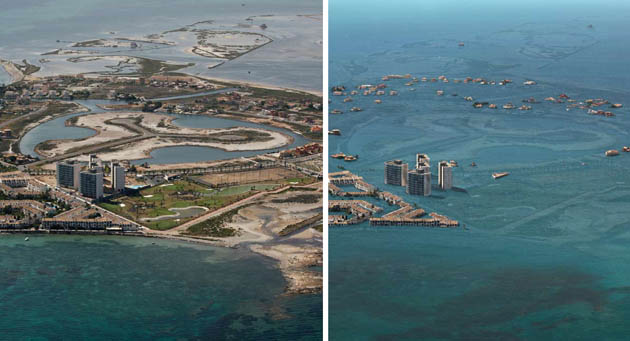 [Image: By Pedro Armestre and Mario Gómez].
[Image: By Pedro Armestre and Mario Gómez].
In fact, these and other visions of altered planetary conditions might inadvertantly be stimulating people's interest in experiencing the earth's unearthly future. Why travel to alien landscapes when you can simply hang around, driving your Hummer...?
A few years go by and the planet is suddenly different.
So if the speculative landscapes pictured here are both imminent and immanent – if they are both inevitable and hidden inside the landscapes we see today, simply waiting for their opportunity to materialize (through drought, flood, fire, etc. etc.) – then there also seems to be a growing curiosity about what the world of tomorrow will really look like.
But mere seeing, I would guess, is not enough: I would assume, in fact, as more images of our climate-changed future are produced, that more and more people will simply gear themselves up to experience that future firsthand. If this is what's coming, then let's buy more bottled water.
Climate change is the adventure tour of a lifetime – and all it requires is that you wait. Then all the flooded hotels of Spain and south Florida will be yours for the taking.
Given images like these, the future looks exciting again.

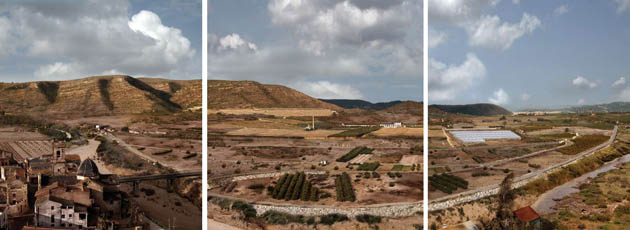 [Images: By Pedro Armestre and Mario Gómez].
[Images: By Pedro Armestre and Mario Gómez].
Of course, such thinking is absurd; thinking that flooded cities and continent-spanning droughts and forest fires will simply be a convenient way to escape your mortgage payments is ridiculous. Viewing famine, mass extinction, and global human displacement into diarrhea-wracked refugee camps as some sort of Outward Bound holiday – on the scale of a planet – overlooks some rather obvious downsides to the potentially catastrophic impact of uncontrolled climate alteration.
Whether you're talking about infant mortality, skin cancer, mass violence and rape, waterborne diseases, vermin, blindness, drowning, and so on, climate change entails radically negative effects that aren't being factored into these escapist thought processes.
But none of those things are depicted in these images.
These images, and images like them, don't show us identifiable human suffering.
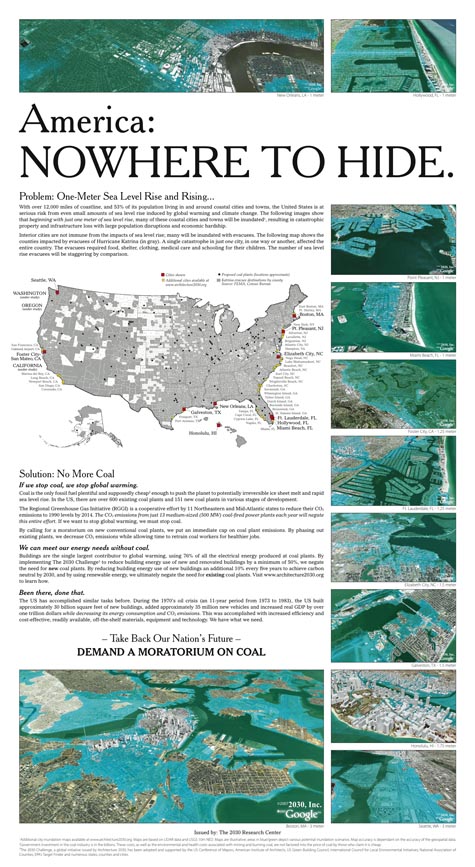 [Image: A full-page ad in The New York Times by Architecture 2030].
[Image: A full-page ad in The New York Times by Architecture 2030].
So what do these images show us?
What we see is a world transformed, made unearthly, like something from a J.G. Ballard novel. Where there once was a pristine beach, the sea has returned, giving us modern ruins: sandbars in the lobbies of hotels, tide pools accumulating on the boardwalks of towns you didn't like in the first place. What appear to be coral reefs are the underwater remains of marinas. What look like atolls are lost subdivisions, or banks at the bottom of the sea.
Maintaining the J.G. Ballard reference, this description is from his book The Drowned World:
My point in saying all this is simply that these images don't shock; they're more like posters for tomorrow's specialty tourism firms.
After all, there is no one way to interpret these images; there is no singular narrative by which to understand them, or comprehend them.
Just look at photographs of New Orleans after Hurricane Katrina: that drowned city, for the political Left, became a symbol of all that is wrong with American Conservativism – that people like Dick Cheney would launch debt-fueled oil wars in the deserts of foreign countries while remaining blind to problems of national infrastructure back home – yet, for the political Right, New Orleans was a sign of what happens when you're forced to rescue, over and over again, a whole social class that refuses, or is systematically unable, to look after itself.
In other words, go show someone a photograph of New Orleans underwater – then tell me what they say that photograph "means" to them.
Then show them these images.
Then tell me what these images mean.
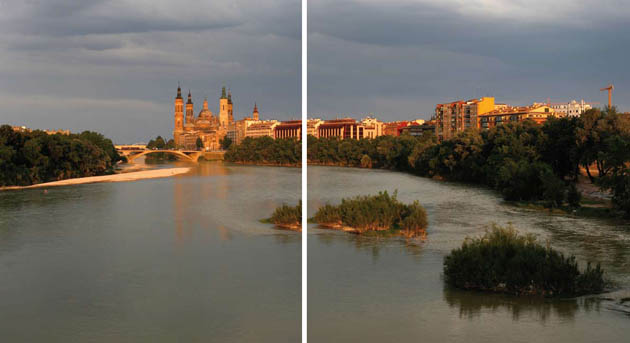
 [Images: By Pedro Armestre and Mario Gómez].
[Images: By Pedro Armestre and Mario Gómez].
What are we supposed to take away from these scenes, then?
Does the religious Right look at these images and see what the political Left sees – or even what the financial Right sees, that opportunity-seeking managerial class of entrepreneurs and venture capitalists? What about New Age utopians? What about BLDGBLOG readers?
What about Muslim fundamentalists? Do visions of a submerged Manhattan make Hamas want to burn less oil?
Because there is not one singular explanation for these images; there is not one scientific narrative or political diagnosis that everyone will agree on.
Some people, as I've said, may even be excited: South Beach is under five feet of water...? Get your camera...
In any case, interpreting these Greenpeace images gets even more interesting when you reverse the original sequence in which some of them first appeared.
 [Images: By Pedro Armestre and Mario Gómez].
[Images: By Pedro Armestre and Mario Gómez].
Let's say, then, that here, in the image featured above, we are looking at central California before corporate water lobbyists have pushed huge irrigation bills through Congress. We see unaffected Nature, with a capital N, with all its colors and rough edges: the water has yet to arrive, flowing in from distant pumps and reservoirs, and so Nature is still in balance with itself. It may be dry, in other words, but it is still vaguely Edenic.
Now, however, in the image below, let's say that this is what money, influence, and tightly controlled aqueducts will bring.
What should be desert, in other words – raw, beautiful desert – has become an apricot farm: gridded, geometric, and designed to turn a profit.
 [Images: By Pedro Armestre and Mario Gómez].
[Images: By Pedro Armestre and Mario Gómez].
Again, my point is simply that these images lend themselves to a huge variety of interpretations – and so looking at them, in any order, can result in someone being offended, whether that someone is an environmentalist, a preacher, or a libertarian taxpayer.
And yet my intention is not to question – or, worse, trivialize – the effects of climate change, or to imply that the real danger of climate change is that someone will be "offended" by it; my intention is simply to question the visual rhetoric through which climate change is now being addressed.
How do we visually represent climate change in a way that will make more people take it seriously?
Because cinematic, quasi-Spielbergian images of drowned cities simply don't accomplish that.
Only half-jokingly, I might even suggest that the real way to scare people about climate change – assuming that fear is the correct tactic to use here – is not through referring to landscape at all, but through threats involving 1) sex and 2) children.
All that pollution... so much carbon in the atmosphere... dirty water, social unrest, lack of food...
Well, your prostate will swell with metal and your kids will all drown.
In any case, aerial views of an underwater Manhattan, or Romantic landscape photographs of the Spanish countryside, simply do not inspire people to turn the lights down or drive their Escalades less frequently.
If you want to use fear – and that's a huge if – then choose something scary.
As it is, we're being told that we should worry about climate change... because it resembles one of the most exciting tropical adventures ever to befall the human race.
Who's going to get upset about that?
(Remarkably similar thoughts can be found in BLDGBLOG's earlier post: Liberation Hydrology: Miami, 2107 A.D.).
The images show us what Spain will look like in the future, in a world transformed by climate change.
 [Image: By Pedro Armestre and Mario Gómez].
[Image: By Pedro Armestre and Mario Gómez].The basic idea here is that these visions of flooded resort hotels, parched farmlands, and abandoned villages, half-buried in sand, will inspire us to take action against climate change. Seeing these pictures, such logic goes, will traumatize people into changing how they live, vote, consume, and think. You can visually shock them into action, in other words: one or two glimpses of pictures like these and you'll never think the same way about climate change again.
But I'm not at all convinced that that's what these images really do.
 [Image: By Pedro Armestre and Mario Gómez].
[Image: By Pedro Armestre and Mario Gómez].In fact, these and other visions of altered planetary conditions might inadvertantly be stimulating people's interest in experiencing the earth's unearthly future. Why travel to alien landscapes when you can simply hang around, driving your Hummer...?
A few years go by and the planet is suddenly different.
So if the speculative landscapes pictured here are both imminent and immanent – if they are both inevitable and hidden inside the landscapes we see today, simply waiting for their opportunity to materialize (through drought, flood, fire, etc. etc.) – then there also seems to be a growing curiosity about what the world of tomorrow will really look like.
But mere seeing, I would guess, is not enough: I would assume, in fact, as more images of our climate-changed future are produced, that more and more people will simply gear themselves up to experience that future firsthand. If this is what's coming, then let's buy more bottled water.
Climate change is the adventure tour of a lifetime – and all it requires is that you wait. Then all the flooded hotels of Spain and south Florida will be yours for the taking.
Given images like these, the future looks exciting again.

 [Images: By Pedro Armestre and Mario Gómez].
[Images: By Pedro Armestre and Mario Gómez].Of course, such thinking is absurd; thinking that flooded cities and continent-spanning droughts and forest fires will simply be a convenient way to escape your mortgage payments is ridiculous. Viewing famine, mass extinction, and global human displacement into diarrhea-wracked refugee camps as some sort of Outward Bound holiday – on the scale of a planet – overlooks some rather obvious downsides to the potentially catastrophic impact of uncontrolled climate alteration.
Whether you're talking about infant mortality, skin cancer, mass violence and rape, waterborne diseases, vermin, blindness, drowning, and so on, climate change entails radically negative effects that aren't being factored into these escapist thought processes.
But none of those things are depicted in these images.
These images, and images like them, don't show us identifiable human suffering.
 [Image: A full-page ad in The New York Times by Architecture 2030].
[Image: A full-page ad in The New York Times by Architecture 2030].So what do these images show us?
What we see is a world transformed, made unearthly, like something from a J.G. Ballard novel. Where there once was a pristine beach, the sea has returned, giving us modern ruins: sandbars in the lobbies of hotels, tide pools accumulating on the boardwalks of towns you didn't like in the first place. What appear to be coral reefs are the underwater remains of marinas. What look like atolls are lost subdivisions, or banks at the bottom of the sea.
Maintaining the J.G. Ballard reference, this description is from his book The Drowned World:
- Giant groves of gymnosperms stretched in dense clumps along the rooftops of the submerged buildings, smothering the white rectangular outlines... Narrow creeks, the canopies overhead turning them into green-lit tunnels, wound away from the larger lagoons, eventually joining the six hundred-yard-wide channels which broadened outwards toward the former suburbs of the city. Everywhere the silt encroached, shoring itself in huge banks against a railway viaduct or crescent of offices, oozing through a submerged arcade... Many of the smaller lakes were now filled in by the silt, yellow discs of fungus-covered sludge from which a profuse tangle of competing plant forms emerged, walled gardens in an insane Eden.
My point in saying all this is simply that these images don't shock; they're more like posters for tomorrow's specialty tourism firms.
After all, there is no one way to interpret these images; there is no singular narrative by which to understand them, or comprehend them.
Just look at photographs of New Orleans after Hurricane Katrina: that drowned city, for the political Left, became a symbol of all that is wrong with American Conservativism – that people like Dick Cheney would launch debt-fueled oil wars in the deserts of foreign countries while remaining blind to problems of national infrastructure back home – yet, for the political Right, New Orleans was a sign of what happens when you're forced to rescue, over and over again, a whole social class that refuses, or is systematically unable, to look after itself.
In other words, go show someone a photograph of New Orleans underwater – then tell me what they say that photograph "means" to them.
Then show them these images.
Then tell me what these images mean.

 [Images: By Pedro Armestre and Mario Gómez].
[Images: By Pedro Armestre and Mario Gómez].What are we supposed to take away from these scenes, then?
Does the religious Right look at these images and see what the political Left sees – or even what the financial Right sees, that opportunity-seeking managerial class of entrepreneurs and venture capitalists? What about New Age utopians? What about BLDGBLOG readers?
What about Muslim fundamentalists? Do visions of a submerged Manhattan make Hamas want to burn less oil?
Because there is not one singular explanation for these images; there is not one scientific narrative or political diagnosis that everyone will agree on.
Some people, as I've said, may even be excited: South Beach is under five feet of water...? Get your camera...
In any case, interpreting these Greenpeace images gets even more interesting when you reverse the original sequence in which some of them first appeared.
 [Images: By Pedro Armestre and Mario Gómez].
[Images: By Pedro Armestre and Mario Gómez].Let's say, then, that here, in the image featured above, we are looking at central California before corporate water lobbyists have pushed huge irrigation bills through Congress. We see unaffected Nature, with a capital N, with all its colors and rough edges: the water has yet to arrive, flowing in from distant pumps and reservoirs, and so Nature is still in balance with itself. It may be dry, in other words, but it is still vaguely Edenic.
Now, however, in the image below, let's say that this is what money, influence, and tightly controlled aqueducts will bring.
What should be desert, in other words – raw, beautiful desert – has become an apricot farm: gridded, geometric, and designed to turn a profit.
 [Images: By Pedro Armestre and Mario Gómez].
[Images: By Pedro Armestre and Mario Gómez].Again, my point is simply that these images lend themselves to a huge variety of interpretations – and so looking at them, in any order, can result in someone being offended, whether that someone is an environmentalist, a preacher, or a libertarian taxpayer.
And yet my intention is not to question – or, worse, trivialize – the effects of climate change, or to imply that the real danger of climate change is that someone will be "offended" by it; my intention is simply to question the visual rhetoric through which climate change is now being addressed.
How do we visually represent climate change in a way that will make more people take it seriously?
Because cinematic, quasi-Spielbergian images of drowned cities simply don't accomplish that.
Only half-jokingly, I might even suggest that the real way to scare people about climate change – assuming that fear is the correct tactic to use here – is not through referring to landscape at all, but through threats involving 1) sex and 2) children.
All that pollution... so much carbon in the atmosphere... dirty water, social unrest, lack of food...
Well, your prostate will swell with metal and your kids will all drown.
In any case, aerial views of an underwater Manhattan, or Romantic landscape photographs of the Spanish countryside, simply do not inspire people to turn the lights down or drive their Escalades less frequently.
If you want to use fear – and that's a huge if – then choose something scary.
As it is, we're being told that we should worry about climate change... because it resembles one of the most exciting tropical adventures ever to befall the human race.
Who's going to get upset about that?
(Remarkably similar thoughts can be found in BLDGBLOG's earlier post: Liberation Hydrology: Miami, 2107 A.D.).





Comments are moderated.
If it's not spam, it will appear here shortly!
Well, there's already a wealth of human misery photos, be it hunger, war or both...maybe there could be a "middle ground" where the Armestre/Gomez set could intersect that, but it would be explotation.
I rather have this, because it somehow points at the bigger offenders and their idyllical but ultimately wobbly utopias.
Would you rather have an updated photo of Mad Max or Tank Girl? Maybe it's the WaterWorld backlash.
Considering the IPCC predicts only a 30-60cm rise in sea level this century, the pictures themselves are evidence of a yearning for the apocalypse.
my intention is simply to question the visual rhetoric through which climate change is now being addressed.
How do we visually represent climate change in a way that will make more people take it seriously?
One thing that springs to mind is that the destruction of the built landscape has more appeal than, say, a dry riverbed or a burned forest, so I'd probably concentrate on the disasters we're familiar with.
This is idle speculation, but maybe the key is an overall reduction in information...a flooded city is something more, visually, than an unflooded one. A burned forest is something less than an intact one.
Or not.
As far as yearning for the apocalypse goes, I try to remain open to the possibility that these dreams don't mean what they seem to - just as our own dreams about death may not really be about death - and may even be healthy in some sense. It's not always easy to believe that, though....
Fantastic post. Thanks for looking into the subtext of these images and not just taking them at face value. Beautiful.
What a fascinating, subtle and stimulating post. A rare combination when the subject of climate change is at hand.
Thought provoking piece.
I agree that these sanitary photoshop pieces depicting a clean, tropical lagoon where Miami Beach once stood are a lie. That water would be murky and fetid with the decomposition of the natural materials submerged there. I don't see any floating bodies . . . These images don't show just how horrible it would really be. They don't show the death and misery that would befall hundreds of millions of people.
Are we really yearning for the apocalypse with our fascination with it in our entertainment? Do "Children of Men" and "The Road" make you want to experience those stories?
I've always interpreted fiction like that as cautionary tales rather than "Isn't that fun? Gee I wish I could experience that."
The only one that still resonates with me as being somehow idyllic is George Stewart's "Earth Abides."
Humans are fascinated by ruins and the idea of visiting drowned cities, dried up inland seas and fallout contaminated Russian cities as tourists is a tremendous draw for millions.
None of these places are Disneyland, and I think the people touring places like this are doing it in a very serious philosophical way. Similarly, no one goes to NYC Ground Zero, Auschwitz or Chernobyl because it's fun. People do it to feel the ghosts and pay respects. This is the same with ruins.
Still, a drowned Disneyworld sounds utterly fascinating.
I definitely think there's something in us that desperately wants these kinds of things to happen, to be able to envision them, if for no other reason than we hope to be the hollywood hero who survives whatever catastrophe is being dreamt up at the moment.
In a morbid way...these images, places, events, forces, ideas...spark the imagination. They're thrilling.
What else, besides that thrill of possibility, could possibly motivate all the people with the rapture-related bumper stickers?
dude, i can't wait to dive for treasure in manhattan, in beach resorts, in the netherlands!
"Yearning for the apocalypse . . ."
In other words, yearning to be proven right.
The doomsday predictors will always be wrong.
When that day comes, its source will be astonishingly unexpected.
Lost America: Except that there wouldn't be bodies, because the bodies would have left long before things got to that stage. It's not as though there'd be a sudden flood. It's just that the water would get a little bit higher, tide after tide, year after year. It would be like suggesting that glaciers crushed people. Uh, no; glaciers were not known for sneaking up on people like serial killers...
The images are appealing but surely that is what makes us look at them. They attract attention and hopefully make people think.
It is very easy to skip or gloss over articles on global warming because we would rather not know about it or feel we have read it all before. Vivid disturbing images may be ignored by many too.
These images are just one method in an arsenal that need to be employed so that as many people as possible take notice.
I gave your blog design a mention on my sueblimely.com blog as an example of how well blogspot blogs can be designed.
Fair enough Halojones, no bodies.
But the water would still be contaminated and toxic from all the underground fuel storage and sewage as well as all the above ground organic matter like trees and lawns. Floods are filthy nasty things. Look no further than New Orleans for evidence. It will not look like a South Pacific Lagoon as depicted in those images.
ok! You're right in many ways of your critics but, do you think people who live there in those buildings, in their homes, feel the same like you when they look at those photos? I think those photos have a goal people. Don't forget them.
"After all, there is no one way to interpret these images; there is no singular narrative by which to understand them, or comprehend them."
Christ, this is the post-post-post-post-Modern era. embrace ambiguity and stop trying to second-guess. there's no such thing as meaning anymore.
Yup. Landscape is ambiguous - it's absolutely a mental construct.
Mountains were ugly warts on the Earth before the Romantic painters decided to depict them as beautiful. Nowadays we have "cultured landscapes" like heaths and plains; grazing sheep didn't degrade the landscapes, it turns out, they created new ones! And harbors, abandoned mines, crumbling warehouses now count as "industrial landscapes".
Maybe Greenpeace has unwittingly created the "climate change landscape"? The "apocalyptic landscape"? Who knows what disasters we'll be aestheticizing in a few decades.
Apocalypse doesn't frighten us. That earth will be someday be unfit for humans, or to have more opportunities of adventure, more 'natural' ways of living vaguely seems to make life 'purposeful'. Who cares about beautiful architecture, or science, technology and art when you will be able to live a pirate's life!
Waterworld
I suppose I'm curious what types of messages you'd propose instead? I agree that these are probably ineffective disaster porn. Although for me, it is because they are so far removed from human scale that people likely can't connect their experiences with them on a visceral level (which, I think, is what the images are aiming for). Should architects portray exaggeratedly negative catastrophe scenarios? There's been talk in activist circles that the kind of doom is inevitable catastrophe narrative will not lead to action, but to despair. On the other hand, architecture seems to churn out a lot of overly optimistic techno-topia designs that seem to hint political action on climate change is unnecessary because design will save us all. Is it better to show people what they are fighting for, or against? Or some combination. If it is part of our job as designers to explore possibilities (which, I think, it is), how do we take on climate change?
Post a Comment